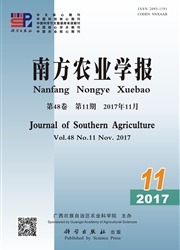

 中文摘要:
中文摘要:
[目的]以叶功能性状划分大明山常绿阔叶林功能型,比较各个功能群功能性状间的联系和变化,探索叶功能性状在植物功能群分类中的适用性.[方法]2012年对大明山天坪区3.2 ha样地内的树种挂牌调查,计算得到各植物的重要值,选取前20种优势木本植物作为研究对象.每种木本植物在样地的上、中、下3坡各选取1棵生长形态相似的植株,测定其叶功能性状(叶面积、叶厚度、叶鲜重、叶干重、比叶面积、叶干物质含量、叶组织密度、叶绿素含量和叶片氮、磷、钾含量)和其他功能性状(茎干密度即Pilodyn值、高径比).通过系统聚类分析划分为3个功能群,并分析3个功能群之间的功能性状.[结果]3个功能群之间只有叶组织密度和茎干密度显著相关,其余的都是两个功能群之间互相显著相关,其中比叶面积只在A功能群和B功能群之间差异显著,叶干物质含量在A功能群和B功能群以及B功能群和C功能群之间差异显著.[结论]广西大明山的常绿阔叶林可以按照叶功能性状划分为3个不同的功能群,不同的功能群之间存在一定的联系,但也有各自的功能群特点.
 英文摘要:
英文摘要:
[ Objective ]By dividing the Daming Mountain evergreen broad-leaf forest functions based on leaf function- al traits, the contacts and changes of each functional group were compared. And then the appiicability of functional traits in plant functional group classification was explored. [ Method ]All woody plants in 3.2 hm2 of Darning Mountain Tianping Area were investigated to select 20 dominant woody plants as study objects based on the calculated important values of all plants. Three samples of each plant with similarity grown on the upper, middle and lower slope were chosen to detect leaf functional traits (such as leaf area, leaf thickness, leaf fresh weight, leaf dry weight, specific leaf area, leaf dry matter con- tent, leaf tissue density, chlorophyll content, nitrogen, phosphorus and potassium contents) as well as other functional traits (including trunk density (Pilodyn) and aspect ratio). The 20 species were divided into three groups according to clus- ter analysis. Functional traits among the three functional groups were also analyzed. [Result]The results showed that only leaf density(LD) and stem density(Pilodyn) were significantly correlated among the three functional group. All the others were significant correlated between two functional groups. Specific leaf area was significantly correlated between group A and group B. Leaf dry matter content was significantly correlated between group A and group B as well as group B and group C. [Conclusion]According to leaf functional traits, evergreen broad-leaved forest in Darning Mountain Nature Re- serve, Guangxi could be classified into three functional groups, which had their own features but mutual connections as well
 同期刊论文项目
同期刊论文项目
 同项目期刊论文
同项目期刊论文
 期刊信息
期刊信息
